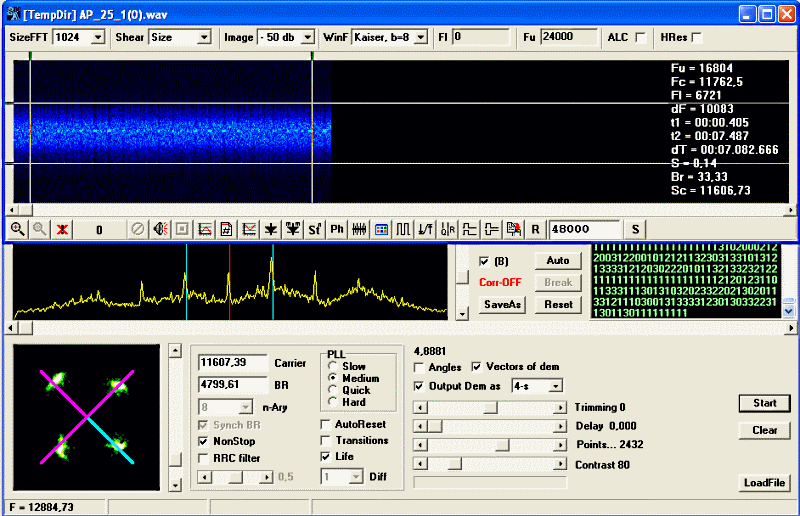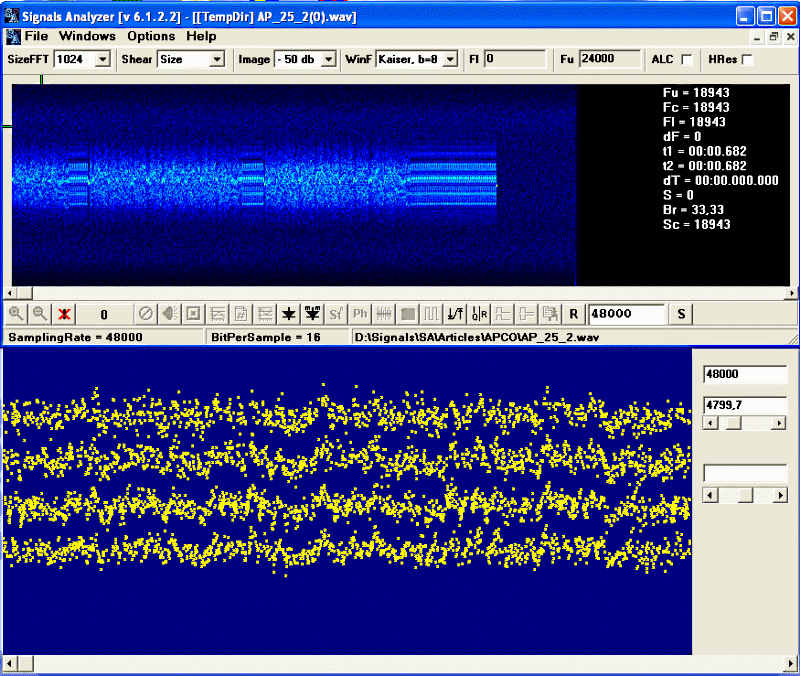|
|
| Разместил (Author): |
SergUA6  |
| Авторские права |
© http://www.radioscanner.ru |
|
|
Текст
|
APCO-25, is qualitative decoding possible from discriminator's output?
Appearance of DSD program, which provides decoding of standard APCO-25, has called on ours (and not only) forum active enough discussion. The program processes an audiostream from an output of the discriminator of any FM receiver, and solves demodulation and decoding tasks in real time.
Discussion on our forum is concerned the problem: is it possible to provide qualitative demodulation and decoding of standard APCO-25 from discriminator's output?
We will try to answer this question.
Thanks to high activity of participants of our forum, there is enough of records of standard APCO-25 in I/Q format, IF and the ones which are direct from the discriminator. The quantity of these records is sufficient to be able to give an answer on this question with more or less deep arguments and convincingly.
Modulation C4FM, which is used in APCO-25 standard, is very closely linked with modulation pi/4DQPSK, it allows to demodulate a signal as pi/4 DQPSK.
Example: http://www.radioscanner.ru/info/files/article412/ap_25_1.wav

But in this case, the signal's processing is realized on zero IF and the signal demands representation in the form of I/Q, or, similar results can be received on intermediate frequency (IF).
At the same time, modulation C4FM represents itself four-level FSK, and it can be demodulated as usual FSK (MFSK) modulation with usage of the standard discriminator. It saves compatibility with old analogue standards.
We do not know, how demodulation in concrete models of radio stations APCO-25 is realized, but at least we can estimate, what is possible to take into account with using only discriminator's output.
So now we need:
1) records of APCO-25 signals
2) SA
3) the small program for mapping(displaying) of levels of a signal from the discriminator
4) desire and time.
The small program is written specially for this article. This program imitates the simple demodulator, displaying levels from discriminator's output, with necessary clock frequency.
On the very qualitative signal, after all necessary conversions/procedures in SA, we receive the following results:
An output from the discriminator after the phase detector.

Result of demodulation.

On the upper image the part, which corresponds to exact clock synchronization is selected - it is that what is possible to receive on this signal. Complete synchronization is shown in the lower image.
It is obvious, that errors at demodulation are not avoidable. Although, in general, the result of demodulation is sufficient, but not for the signal of such quality, which is selected for the example.
Of course, considering powerful noise-resistant coding, which is used in standard APCO-25, decoding most likely will be realized qualitatively enough. However, it is obvious, that reception of a bit stream from discriminator's output without any processing is extremely undesirable.
Simple, preliminary, more or less optimal filtering, sharply raises chances for faultless demodulation.

Almost an ideal picture. At well organized clock synchronizations, the signal will be demodulated qualitatively. In the small program-simulator, which results are shown, clock synchronization is very simple.
Under standard APC0-25, after the discriminator, RRC filter is necessary with parameter alpha = 0.2.
However, it is possible to use any optimal filtration instead RRC filter.
It may seem, that the answer is gotten: it is possible to receive qualitative bit stream and qualitative decoding from discriminator's output. But the answer will be not complete if not to consider other aspects and problems which are surely exist.
The matter is that the signal, which we has been taken for an example, is too good, and does not mirror all problems of demodulation.
Here is another signal http://www.radioscanner.ru/info/files/article412/ap_25_2.wav , such meet very often.
After all conversions and optimal filterings, the result is about the such.:

Surely, there will be demodulation errors, but it is possible to minimize or avoid them, having provided:
1) signal's parameters tracking in demodulator ;
2) correction of levels of decision-making.
Because, hard logic, which perfectly works on qualitative signals, will not work in this case.
We can meet such signals very often, with the bigger or smaller distortions. An origin of these distortions is not known to me, but I assume that it can be result of operation of various repeaters, probably not serviceable or not certificated ones, and/or features of signal's transfer. Signals of such quality, naturally have worst parameters of a noise stability and reliability.
The discriminator's output can be certainly used for decoding APCO-25, but qualitative implementation, is not easy task as it can seem at first sight, this task demands the serious approach.
As we have received some letters, concerning the question of conversion of bit stream APCO-25 received in SA from the phase demodulator, I result the map of conversions to bits. Signal APCO-25 demodulated in SA, in relative mode, same as it is represented in the first image in this article. In this case correspondence of the real dibits and positions of angles is the followin:
0 - 10
1 - 00
2 - 01
3 - 11
Do not forget that signal's inversion is possible, then the values will be:
0 - 00
1 - 10
2 - 11
3 - 01
It is possible to define inversion indirectly by series zero bits, which always are present in APCO-25 bit stream, not less than 15-20 bits in a row. In not inverted signal, in the stream from SA demodulator, it corresponds to series 1, in inverted to series 0. The length of these series is not less than 7-10 characters/symbols (15-20 bits).
That is it.
Good luck~
|
|
|
|
Добавлять комментарии могут только зарегистрированные, активировавшие регистрацию и не ограниченные в доступе участники сайта!
|
| Файл создан: 25 Apr 2010 01:37, посл. исправление: 27 Apr 2010 17:57 |
|

